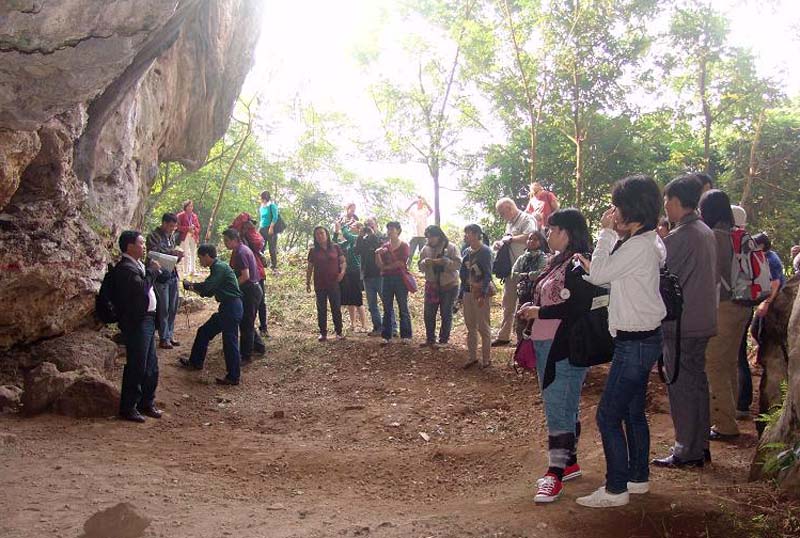
(HBO) - Hoa Binh city Currently there is a road and a hotel named Colani in Hoa Binh City. It is a tribute to the French archaeologist, Madelene Colani, who has proposed the concept of "Hoa Binh Culture” and it is also for the other generations of Hoa Binh people to know and be proud of the place where they are living, which is the cradle of "Hoa Binh Culture”.
Hoa Binh culture is a famous culture of the prehistoric period, which was 18,000 years ago. This is a typical culture in the mainland Southeast Asian countries, in southern China and in the western part of the delta of the 3 big rivers in Northern Vietnam, in which there is Da River running through the territory of Hoa Binh province.
From the excavation of relic sites of the caves in the limestone mountainous area of Hoa Binh, in 1927, the French archaeologist, Madelene Colani, proposed the concept of "Hoa Binh Culture”. Accordingly, in 1932, the first conference of Far Eastern prehistoricists meeting in Hanoi recognized the term "Hoa Binh Culture” as a term to refer to an ancient culture that appeared and existed on territory of prehistoric Vietnam, and affirmed that Hoa Binh was one of the centers of the primitive people in Vietnam.
According to the research by M.Colani: the residents of "Hoa Binh Culture” used to live in groups in caves, hunting and collecting food for a living. The people at that time knew how to use pebbles with their crafting to create almond-shaped, disk-shaped and later short ax-shaped tools.
Ms. Nguyen Thi Thi, the Director of the Provincial Museum, who has studied and unearthed the archaeological relics related to the "Hoa Binh culture” for hundreds of times says: Currently, over 130 sites under Hoa Binh culture” have been discovered in Vietnam, of which, there are over 70 relics discovered and studied in Hoa Binh. The archaeological sites belonging to "Hoa Binh culture” are mainly located in the caves and on the stone roofs.
They have been discovered in Can cave, in the cave of Trai hamlet, on the stone roof of Vong hamlet, on the stone roof of Tom, on the stone roof of Chieng Khen, in the cave of Doi hamlet, in Muoi cave and so on. These common relics in "Hoa Binh culture” is the kitchen, the burial tombs, the post-meal ruins, the labor tools and the other artifacts of the primitive people. The traces of the clam shells, snails, the animal teeth and bones, and the nut shells of some herbs have been remained in the cultural layer and a large number of relics, animal and human bones.
Currently, a number of relics are stored in the Provincial Museum. They are on the display on the occasion of the province's major holidays and they have been participating in thematic exhibits at the regional level with a view to introducing the visual images showing the steps of human evolution through "Hoa Binh Culture”. The displays on "Hoa Binh Culture” are often the simulations and reconstruction of a cave of the accommodation of the primitive people. There are the people, the fire stoves, the stone working tools, and there are a lot of shells, stone tools and pieces of scrap (eaten and left by humans) on the floor of the cave.
Proudly living in the cradle of "Hoa Binh culture”, Hoa Binh people always raise the awareness of preserving and promoting the cultural identity, creating their own characteristics of the gateway land of the Capital and the gates in the Northwest of the country.
The researchers and the students are visiting the relics of Trai cave, Tan Lap commune (Lac Son) - an excavation of the related to "Hoa Binh culture”
Xoe dance, an unique art form of the Thai ethnic minority group in Mai Chau district of Hoa Binh province has existed for a long time and passed down through generations. Xoe dance is not only a popular dance in the Thai community but also a unique cultural feature, an indispensable part in the Thai ethnic minority people's cultural and spiritual life.
The Bac Son pre-school in Hung Son commune, Kim Boi district is effectively implementing a model of preserving and promoting cultural identity of the Muong ethnic group.
Through ups and downs, many unique cultural features of the Muong ethnic minority group are facing risks of falling into oblivion. However, with a strong determination, Lac Son district of Hoa Binh province has deployed synchronous solutions to preserve and promote the locality's cultural heritage values.
If Tan Lac is considered the core of the cradle of Muong culture in Hoa Binh, Phong Phu commune is the cultural centre of Muong culture in Tan Lac district. Luy Ai hamlet in Phong Phu commune is where customs and traditions of Muong Bi are preserved. Luy Ai hamlet was chosen to build a space to preserve Muong ethnic culture. The district is seeking support from the province and coordinating with relevant agencies to devise a plan on preservation of Muong cultural spaces associated with developing tourism products and improving the lives of local residents.
Nguyen Manh Tuan, a Muong ethnic man in Ba Hang Doi town, Lac Thuy district, is known as a young, dedicated, and outstanding artisan who has made significant contributions in collecting, restoring, and preserving national cultural values.
The Government Office with Document No. 2082/VPCP-KGVX, dated March 29, 2024, sent out the opinion of Deputy Prime Minister Tran Hong Ha regarding the submission of the "Mo Muong" and "Cheo art" dossiers to the United Nations Educational, Scientific and Cultural Organization (UNESCO).



